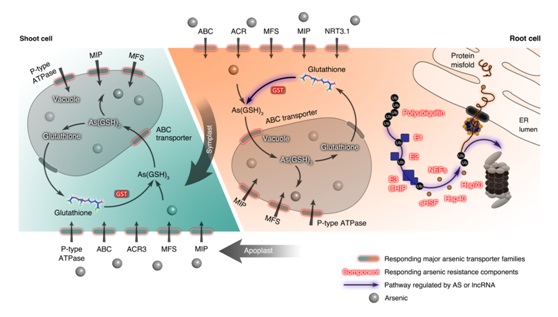Pteris vittata is a vital model plant of arsenic hyperaccumulation and the arsenic in soil can be rapidly absorbed by P. vittata and subsequently translocated into its shoots (fronds). Statically, the total arsenic accounted for up to 2.3% in the dry biomass of P. vittata, which is far above the arsenic concentration of other non-hyperaccumulation plants.
However, the lack of omics information has seriously limited the research on its arsenic hyperaccumulation and regulation mechanism.
The Research Group led by Dr. Zhenyan He from the Key Laboratory of Plant Resources, Institute of Botany, Chinese Academy of Sciences and their collaborators successfully constructed a hyperaccumulation-regulation network and revealed the arsenic hyperaccumulation mechanism in P. vittata by using single-molecular real-time (SMRT) sequencing technology, next generation sequencing (NGS) technology and tonoplast proteomic analysis.
By analyzing the differentially expressed genes between the controlled and arsenic-treated tissue-specific plant samples, a series of molecular elements were identified, including major intrinsic proteins (MIPs), major facilitator superfamily (MFS), P-type ATPases, nitrate transporter 3.1 family (NRT3.1), arsenic antiporter (ACR3) and ATP-binding cassette (ABC) transporters. These genes are thus regarded as putative arsenic transporters in arsenic hyperaccumulation process of P. vittata.
The differential expression of genes from endoplasmic reticulum-associated degradation (ERAD) pathway and glutathione metabolisms also highly correlate to different arsenic treatments, which were considered as arsenic detoxification systems. Long non-coding RNAs and alternative splicing events were found to be involved in the arsenic hyperaccumulation as regulation elements.
Collectively, this study initially created the full-length transcriptomic and proteomic database of P. viittata and unraveled its hyperaccumulation-regulation network, which had offered the potential genetic basis for constructing engineered plants for arsenic phytoremediation in the future.
The study entitled "Potential use of the Pteris vittata arsenic hyperaccumulation-regulation network for phytoremediation" has been published in Journal of Hazardous Materials.
This work was supported by the grants from Chinese Academy of Sciences, National Key Research and Development Program of China and Innovation Training Programs for Undergraduates, CAS.

The vital model arsenic hyperaccumulator P. vittata at different growth stages (by Ma Mi and He Zhenyan)

Arsenic hyperaccumulation mechanism and its regulatory network in Pteris vittata (Image by Yan Huili and Gao Yiwei)
Pteris vittata is a vital model plant of arsenic hyperaccumulation and the arsenic in soil can be rapidly absorbed by P. vittata and subsequently translocated into its shoots (fronds). Statically, the total arsenic accounted for up to 2.3% in the dry biomass of P. vittata, which is far above the arsenic concentration of other non-hyperaccumulation plants.
However, the lack of omics information has seriously limited the research on its arsenic hyperaccumulation and regulation mechanism.
The Research Group led by Dr. Zhenyan He from the Key Laboratory of Plant Resources, Institute of Botany, Chinese Academy of Sciences and their collaborators successfully constructed a hyperaccumulation-regulation network and revealed the arsenic hyperaccumulation mechanism in P. vittata by using single-molecular real-time (SMRT) sequencing technology, next generation sequencing (NGS) technology and tonoplast proteomic analysis.
By analyzing the differentially expressed genes between the controlled and arsenic-treated tissue-specific plant samples, a series of molecular elements were identified, including major intrinsic proteins (MIPs), major facilitator superfamily (MFS), P-type ATPases, nitrate transporter 3.1 family (NRT3.1), arsenic antiporter (ACR3) and ATP-binding cassette (ABC) transporters. These genes are thus regarded as putative arsenic transporters in arsenic hyperaccumulation process of P. vittata.
The differential expression of genes from endoplasmic reticulum-associated degradation (ERAD) pathway and glutathione metabolisms also highly correlate to different arsenic treatments, which were considered as arsenic detoxification systems. Long non-coding RNAs and alternative splicing events were found to be involved in the arsenic hyperaccumulation as regulation elements.
Collectively, this study initially created the full-length transcriptomic and proteomic database of P. viittata and unraveled its hyperaccumulation-regulation network, which had offered the potential genetic basis for constructing engineered plants for arsenic phytoremediation in the future.
The study entitled "Potential use of the Pteris vittata arsenic hyperaccumulation-regulation network for phytoremediation" has been published in Journal of Hazardous Materials.
This work was supported by the grants from Chinese Academy of Sciences, National Key Research and Development Program of China and Innovation Training Programs for Undergraduates, CAS.

The vital model arsenic hyperaccumulator P. vittata at different growth stages (by Ma Mi and He Zhenyan)

Arsenic hyperaccumulation mechanism and its regulatory network in Pteris vittata (Image by Yan Huili and Gao Yiwei)
